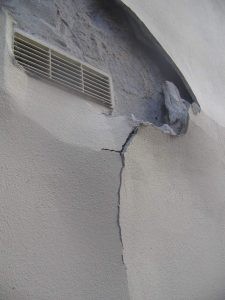Damp Walls & Cracked Render. Can defective render be repaired>
Cracks in render can allow the ingress of water, concrete renders tend to hold & trap the water in pockets of hollow render
Cracks in your render can be hard to see, the render may appear to be solid and in good condition but if you tap it, you may hear hollows indicating it has blown and come away from the wall. Even tiny hairline cracks can allow the passage of water which can enter the inner wall of your home
Establishing the cause (or causes) of the damp problem is the key to finding the solution. As to whether a defective render can be repaired a lot depends on the overall condition of the render and the amount of render defects.
Damp in render can also be caused by rinsing damp if the damp course has been bridged
Cracks in render allowing damp inside walls can happen if the outside walls have a defective render stuck onto them (or if it’s not too well bonded)
If you have cracks in your render or other defects you may be wondering how to stop & cure any existing damp in your walls or prevent future damp problems before they get more serious
What’s the best way to repair render and to stop cracks from reappearing on the wall?
Cement renders set chemically, for a good bond the render base coat needs to be absorbed into the surface it’s going over.
It’s important to prepare the substrate properly, such as cleaning and removing paint from bricks, removing pebbledash, and render.
Even something as simple as washing down walls before rendering to remove dirt and algae can also help with adhesion.

If you have a wall that is exposed to the elements (South/Westerly) and subject to wind-driven, moisture can get through the render and into the home.
Read more about Penetrating Damp
Water penetration can be more problematic if the walls are solid. Sometimes damp in the render can be caused by the render being too absorbent. Damp cracked render may be caused by the render mix not being of the correct type with incorrect sands and the ratios of ingredients
Wall Renders can come in all forms and shapes, such as renders that are made on-site in small cement mixers or mixed by paddle mixer or hand. Renders made in a cement mixer usually consist of sand and cement and sometimes admixtures such as PVA, Latex, frostproofers etc. If the wrong sand is used then you can get problems, cracks occur in the render and allow water ingress. Also, adhesion problems may cause rendering to fail. This could be because the surface under the render was not prepared correctly before rendering it. Previously painted walls that have been rendered may well have adhesion problems
Cracks allow water inside the wall itself. If the mortar mix is to prevent damp in the render, then it needs to be mixed correctly with the correct surface preparation. During our years of surveying, All4Walls has seen many renders fail allowing damp inside the home. Made-in-the-bag renders can be a good idea as they are ready-made a bit like a cake mix. The correct sand with the correct amounts of other ingredients, all you need to do is to add water. Chopped fibre added to the base coat for deep areas can also be useful in limiting the dangers of slumping and cracking in the render. Also, nylon mesh cloth can be embedded between render coats, this virtually eliminates the risk of cracking in render and the subsequent damp problems you get with a defective cracked render finish. Before you get the walls of your home rendered or repaired why not arrange a survey.
We can specify the correct preparation and the correct render material be it lime-based or polymer cement make sure it’s right for your home and will last the test of time to contact us.
